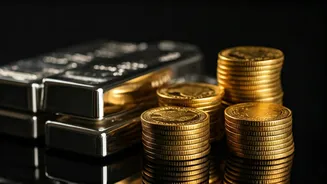Gold's Financial Significance
For Indian households, gold holds significant importance beyond its aesthetic appeal, serving as a vital financial asset. Often viewed as a store of value,
gold is a traditional hedge against inflation and economic uncertainty. Its inherent characteristics, such as limited supply and global demand, typically lead to its value appreciation over time. When gold prices increase, the financial standing of households with gold holdings improves. This helps in building up wealth, thereby boosting financial security, and providing a buffer during economic hardships. Gold is also frequently used as collateral for loans, offering households access to credit and financial resources when required. Hence, rising gold prices significantly impact the wealth profile of Indian households, making them richer.
Factors Driving Price Increase
Various global and domestic factors are at play, influencing the upward trajectory of gold prices. One significant global factor is geopolitical instability, as times of global tension often spur investors toward gold, which is viewed as a safe haven. Additionally, fluctuations in currency exchange rates, particularly the depreciation of the Indian Rupee against the US Dollar, also contribute to the increase in gold prices. On the domestic front, the seasonal demand for gold, especially during festive and wedding seasons, plays a crucial role. Furthermore, government policies, like changes in import duties on gold, can directly affect its price. Economic indicators, such as inflation rates and interest rates, influence investment decisions, subsequently affecting gold prices. A combination of these factors creates a dynamic environment that drives the constant shifts in gold prices in the Indian market.
Economic Implications of Gold
The rising prices of gold have broad economic implications for India. Increased gold prices can stimulate the economy by boosting consumer spending, especially during times of high prices when households feel wealthier and are more willing to invest. This increased spending can further fuel economic growth and create a cycle of prosperity. However, there are potential drawbacks. A continuous rise in gold prices could lead to increased import costs, negatively affecting the trade balance. This can put pressure on the currency and potentially lead to inflation if not managed carefully. Also, high gold prices might divert investment from other sectors, which can hamper broader economic development. Therefore, policymakers must carefully consider the various effects of rising gold prices and implement strategies to ensure sustainable economic growth.
Gold Investment Strategies
Indian households have various options for investing in gold to capitalize on its rising prices. Physical gold, including gold jewelry, coins, and bars, is the most traditional form. However, investors need to consider storage costs and security risks. Gold ETFs (Exchange Traded Funds) and Sovereign Gold Bonds (SGBs) are alternative options that allow investment in gold without holding the physical asset. Gold ETFs track the price of gold, allowing investors to trade on stock exchanges. SGBs are issued by the government, offering interest along with capital appreciation linked to gold prices. These options provide liquidity and are often more cost-effective. Another investment avenue is digital gold platforms, which enable individuals to buy and sell gold online, offering convenience and ease of access. Choosing the right investment strategy depends on individual financial goals, risk tolerance, and investment horizon. It is crucial to conduct thorough research and understand the associated risks and returns before investing.











